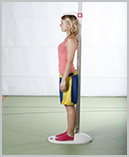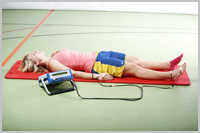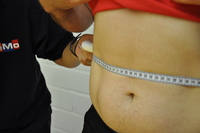Anthropometric tests
Body weight and height
 |
To determine the body mass index (BMI) and to correctly assess height- and weight-dependent test results (for example, the result in the standing long jump is strongly dependent on body height), it is necessary to record these body measurements and take them into account in further tests of the motor skills module. |
Bioelectrical impedance analysis (BIA)
 |
In the so-called BIA measurement, the composition of the body is analyzed. By means of two electrodes attached to each of the right hand and the right foot, an electromagnetic field is built up inside the body. Based on this measurement, the proportions of body water, body fat, lean mass as well as their subdivision into body cell mass (e.g. muscles, organs) and extracellular mass (e.g. bones, cartilage) can be recorded. |
Waist and hip circumference
 |
Waist and hip circumference are important parameters of body measurements. Other parameters are calculated from them. Waist circumference is the narrowest abdominal circumference measured horizontally between the last rib and the pelvis. Hip circumference is measured horizontally at the level of the maximum buttock circumference. The measurement is taken with a flexible but non-elastic tape measure. |
Blood pressure measurement
|
|
Blood pressure is one of the parameters used to measure health parameters. The blood pressure measurement is an oscillometric determination of the systolic and diastolic blood pressure value as well as the pulse rate. The measurement is carried out using a blood pressure monitor validated for children and adolescents.
|


.jpg)